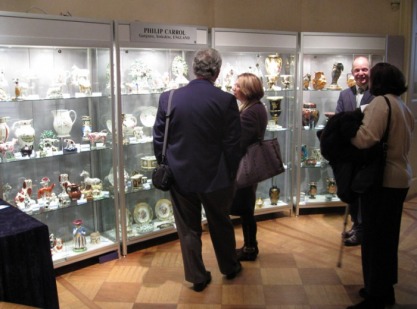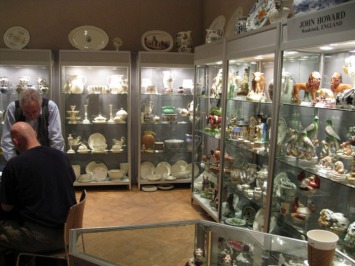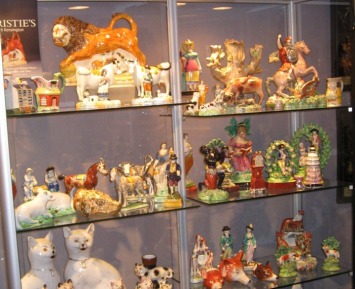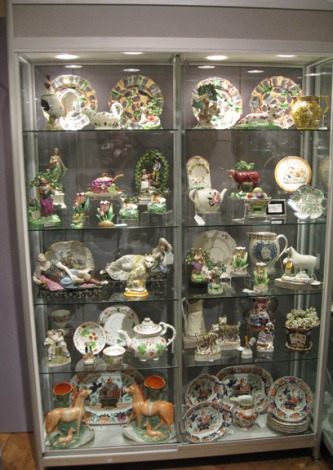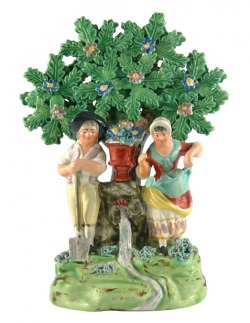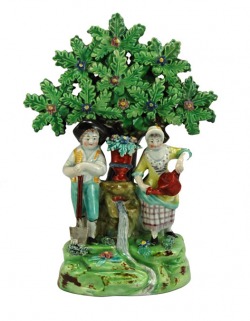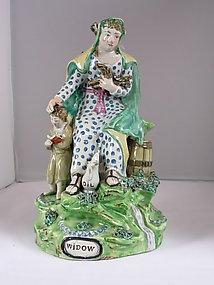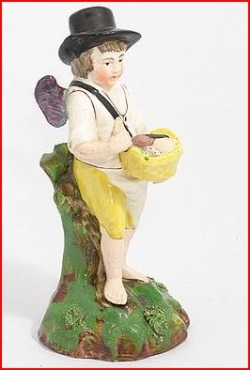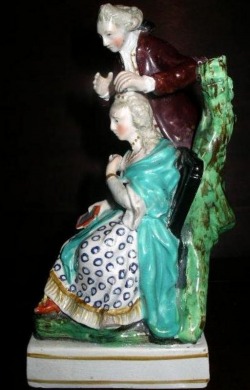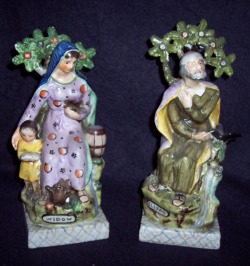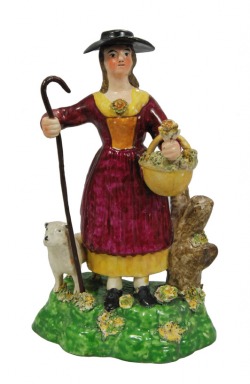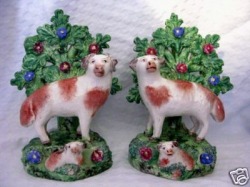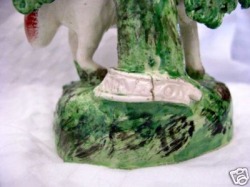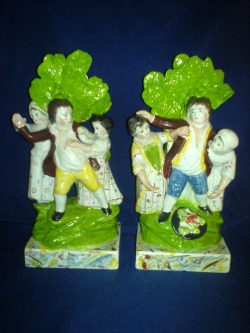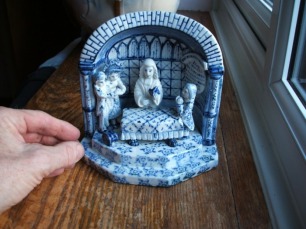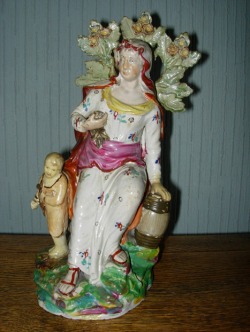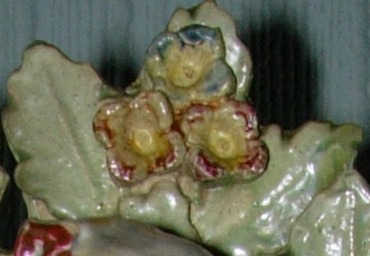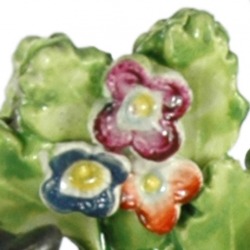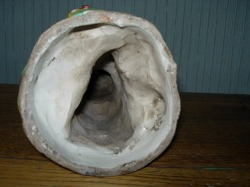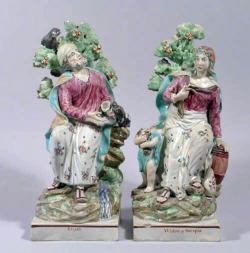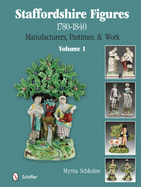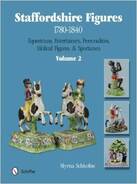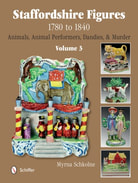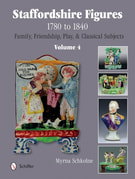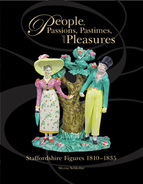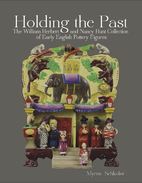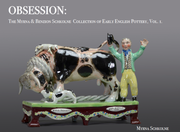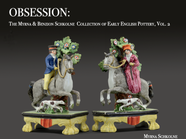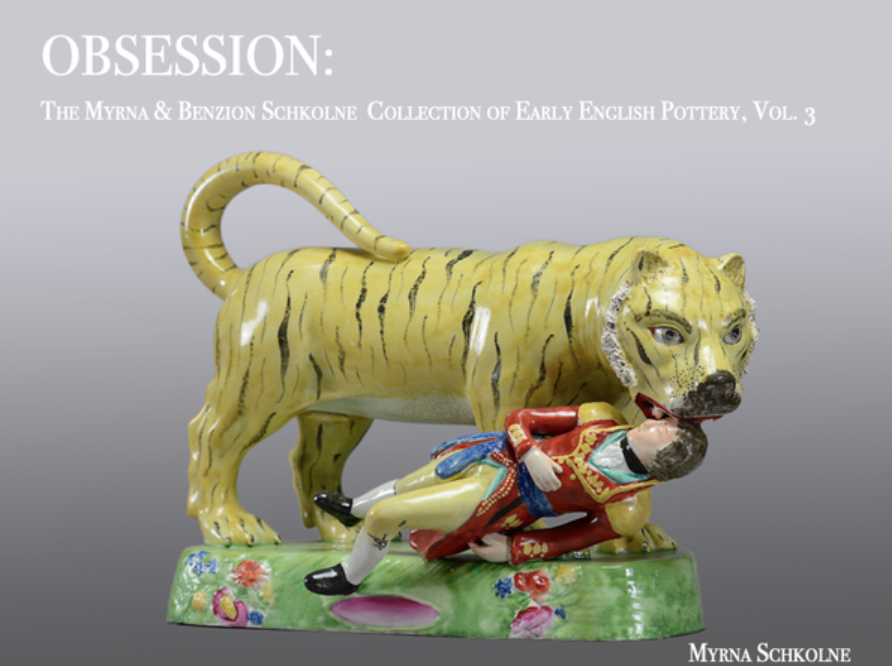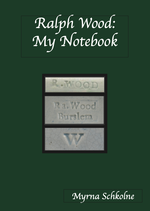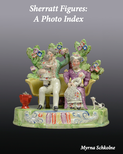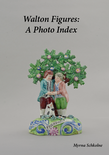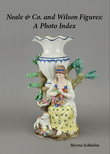|
Instead of a blog entry, I have added another pair of Fabulous Figures to the FIGURES tab on this site...so click on FIGURES to read all about a contest captured in clay. It happened two hundred years ago this year!
0 Comments
The geese know when to head north--and so do I. My annual trek to the New York Ceramics Fair in the month of January starts the year on a high note. If only January were warmer...but the weather was tolerable this year and the pottery never fails to enthrall. The important new face at the fair this year was Philip Carrol, who traveled from Yorkshire (I think) with case loads of varied early wares. Philip has great taste, he sets a high standard, and I hope he will be a regular at the show. I haven't added Philip to the dealer list because I don't have full contact details. I shall remedy that. Meanwhile, if you need to communicate with him, ask me because I can help. Prize for most dazzling display had to go to John Howard. His wares cover a broad period, and he sets a very high standard. You could have left me on his stand forever... As always, Elinor Penna's stand was a firm favorite. Elinor gets the prize for the most figures, and she did justice to both pre-Victorian and Victorian with an amazing array to suite all pockets. Here you could buy a figure for less than the price of a nice hotel room...or you could spend a healthy multiple of that amount. Truly something for everyone. Simon Westman had a fabulous Pratt watch stand, with the figure of Fire to one side and one of the classical ladies on the other. Superb item. I keep hoping Simon will add more and more figures to his stock...and I am sure in time he will. Problem with figures is that they really are in short supply. There were fewer around this year than in the past. Seems that people are slower to send them to market, fearing that they will not get good prices in this market. To the contrary. Prices for anything good are really strong. And the dealers are all hungry for good stock. I hear this again and again. James Labaugh Antiques, as always, had super wares but fewer figures than in prior years. Their stand looked wonderful, though. Although the fair, to all intents and purposes, looked and functioned as always, I spent the days with a very heavy heart. Sampson & Horne were not in their usual spot. Hours before the fair opened on Tuesday, they announced the closure of their business due to Jonathan Horne's ill health. The absence of Jonathan from the ceramics trade is, to me, unimaginable. Jonathan made Staffordshire figure collecting what it is. His meticulous scholarship, his vast knowledge and love of English history, his willingness to mentor and share all that he knew contributed enormously to the ceramics market at all levels. Yes, things will go on unchanged, but for me the ceramics world will never be as bright.
The word Holocaust has gut-wrenching connotations of genocide, the massive destruction of humans by other humans. I am offended when I hear lesser uses of the word: "the holocaust on Wall Street." Please! Even when loss of human life is involved-- be it Asia's heartbreaking tsunami or the AIDS epidemic--the word “holocaust” is inappropriate. Using it trivializes (if that is possible) the enormous tragedy of WW2. Did you read Sophie’s Choice? It is one of the few books I wish I had not read because it has haunted me ever since. A mother’s is forced to choose life for one child, although it means death for the other. So when I heard California’s Governor Schwarzenegger refer to his choice of budget cuts as “a Sophie’s Choice,” my gut heaved. Which brings me to a choice I made a year or so ago. Totally trivial, in the scheme of life, but within my petty existence, it seemed a big decision. I owned a wonderful bocage gardening group. I loved everything about it. Very crisp bocage, great enamels. As you can see, the couple are gardening beside a stream, and we were offered the group years ago while my husband and I were toiling installing a stream to feed our fish pond. Of course, we succumbed, and I thought highly enough of this figure group to use it on the dedication page of my book. I believed I had found the very best example of this figure group that I could possibly find. My collecting philosophy is to buy the best; do it right the first time—no upgrading required. This group had a little restoration to the lady’s arm and the watering can rosette…a pity, but so little restoration! Fast forward many years, and along came another similar gardening group. Although I had never bought a duplicate, the second figure group tempted me because it was PERFECT. I am a sucker for perfection, so I bought it too—at a distance, from an image. It couldn’t possibly be as nice as the first group, I told myself, but I just had to see. When the new purchase arrived, I stood the two groups side by side, and tried to convince myself that figure group 1 remained the best I would ever see. But figure group two had more WOW factor. It stood taller, with a fuller bocage, some nice decorative details on the base, the same top-quality enamels and crisp modeling, and not a chip anywhere...not even a chip to the leaves overhanging the potted plant between the couple. A true miracle. On the other hand, on figure group 1, the skin colors were so pretty and I was emotionally attached to it…but the more I looked at that restored arm, the more it bothered me. So which figure group to keep, which one to sell?
What are friends for if not to help with these decisions? I stood the two figures besides each other, and sent their picture to two friends. Both said it was a no-brainer: figure group 2 was the keeper. NOT what I wanted to hear, but I knew it was right. With great pain, I gave figure group 1 to a dealer to sell for me. It flew out of his stock within moments, and I felt SO much better. My beautiful ceramic child had a loving home and a collector out there was really happy. Last night, I looked at figure group 2 again and knew I had made the right choice. No regrets. Perfection is never over-rated. Found on the web and described as English Pearlware Walton "Widow" figurine, 10 inches high, ca. 1830. Good condition. (Note: woman's thumb is missing.) Nice to know the thumb is missing but I have to ask: WHERE IS THE BOCAGE? And how about this one: Early Staffordshire figure of cupid selling sweets, after a Meissen original, showing a barefoot cupid with a basket of sweetmeats, a black hat to his head, on a grassy mound base. Circa 1800 Condition: very minor enamel loss. I happen to have seen photographs of this figure from a US collector who bought it and returned it. Her concern--and mine: where is the bocage?? Surely "very minor enamel loss" does not include the loss of the whole bocage? Another sighting is this pearlware hairdresser group, offered at $1900. Described as English Pearlware Figure Group, c. 1790-1810. Rare "Hair Dresser." Excellent condition. Minor restored chips. Again, I wonder what happened to the bocage. It is theoretically possible that a bocage could be lost in manufacture...but I have yet to see this. Lest you think 'issues' are confined to bocages, coming up at auction at Chorley's UK on Jan 21 is this uncharming pair. Descrbed as A pair of Staffordshire Ralph Wood type figures, Elijah and the Widow, each seated by a flower encrusted tree, raised on marbled bases An estimate of GBP150-180 goes along with the listing. There is no mention of age, but the figures are of recent manufacture, probably from somewhere in Asia. Staffordshire? Ralph Wood? Ouch!
As snow fell outside last week, the inside of my house was showered in white too. Not pretty large flakes but fine white talc-like stuff that stuck to everything and migrated into all the closets. Sheetrock work. Yuck! I will spare you the details beyond telling you that I am still cleaning and cleaning....and of course, all the pottery has had to be washed. I like staying on schedule with blog postings, but I admit to being exhausted physically and mentally. Brain dead. A picture is always worth a thousand words, so here is one of my favorite figures. Still awaiting a wash, she stands in our bedroom where I can admire her each night. I haven't found a recorded figure quite like this one. There is a handful of shepherdesses in the same spirit, but differences abound. This lady was not without restoration issues, but her beauty and uniqueness compelled me to own her. I knew I would never find another. After all, is she not what Staffordshire is all about?
If this blog posting inspires you to wash your pottery, I apologize. On the other hand, it is the most worthwhile cleaning task. I just flick off the dust, run tepid water over all the surfaces, and stand the figure on a towel to dry. The figure just glow afterwards. Happy housekeeping! Seems to me that luck is in the air...at least for the top bidder on eBay auction 350297890464, because his/her bid was FAILED to meet the reserve. Unsold was this pair of sheep. The sheep are described as "antique Walton sheep figures" and indeed they bear a WALTON mark on the rear. Trouble is that the sheep bear no resemblance to the work of the Staffordshire potter, John Walton, who potted in the early 19th century. The mark is a reproduction mark. The sheep were made long after John Walton was dead and buried--and I have yet to see a bocage like this on any other figure. Strictly speaking, the seller's description is correct: The sheep are "Walton" because, although reproduction Walton, they still bear a Walton mark; they were possibly made in Staffordshire; and they may even be antique--all depending on how you define the word. However, I would not want these sheep for my collection because I don't believe they are The Real Thing. The bidder who failed to meet the reserve after bidding to a whopping $264.95 got lucky. Another lucky person is the seller of eBay auction 270507400367. He describes his 'treasures' thus: Early Staffordshire Figures. Vintage antique items, circa 1820's. Made by Isaac Walton. Both figures have been very well restored. In both cases the boccage has been reconstructed as has the yellow breeches boy's hand. And why is this seller lucky? Simple: he can't see Ugly. If he thinks these figures are lovely--and to be starting the auction at GBP850 he must judge them of merit--surely he must only see beauty everywhere? Beauty is in the eye of the beholder, but I shudder as I look at the massive restoration on these early 19th century objects. I don't believe I have ever seen uglier work. The figures were not made by Isaac Walton, but the seller probably got confused with John Walton. However, this model is NOT the traditional version of Scuffle and Contest that John Walton made. But ignorance is bliss, and so our seller is a blissfully lucky person. And if he gets even a fraction of his suggested opening bid, he will have hit the jack pot. Another lucky seller got GBP286 for this reproduction New Marriage Act. Sold on eBay auction 300378085324. This figure group is not an early 19th century version, and the seller did not represent it as such. But the seller got lucky when the buyer paid GBP 286. Ouch! I guess in this case Luck was a zero-sum game.
BTW, John Hall shows a similar blue and white New Marriage Act in his book Staffordshire Portrait Figures. He dates it as 1822, made by Sherratt. Wrong on both accounts. I am not sure when this group was made but it is NOT early 19thC and is probably a 20thC creation. John Hall's little book is one of my favorite books of yesteryear, but like its contemporaries, it has its inaccuracies. I received an enquiry last week about a figure. The owner had inherited it and knew naught about pottery, but naturally was curious. As the images popped up on my monitor, these thoughts flew through my head: The figure depicts the Widow of Zaraphath, usually found paired with Elijah. This figure was made by Ralph Wood. I know this because the rainbow coloring on the base is repeatedly found on figures made by Ralph Wood. Yes, I know painters moved from potbank to potbank, so painting alone should not be used as a basis for attribution, but I have yet to see this distinctive rainbow of colors on anything but a Ralph Wood figure. BUT the bocage on the figure is totally wrong for this figure. The bocage is of a form that we see repeatedly on Sherratt-style figures, not on Ralph Wood figures. Perhaps the bocage was taken off another figure to replace our Widow's bocage when it broke. However, best I can tell from the picture, the bocage is probably a replacement made by a restorer in recent decades. Why do I think this bocage is a modern creation? Firstly, the shade of green is wrong for early 19th century green and the painting looks yukky. You could argue that the bocage may merely have been overpainted, but I see telling evidence that it is completely restored--made from modern material. Look at the tiny pimply bumps and pock marks on the surface of the leaves. Restored goop often looks like this. Also, the leaves are not as crisp-edged as I would have expected, and there is no glaze puddled in the center of each little flower--a feature I especially enjoy on this particular bocage style. Below is how the bocage should look. Also, the figure has a problem at its other extreme. Look beneath the base. ALSO The round base that supports our Widow today was once mounted upon another base. The photograph taken from beneath the figure shows an unglazed rim and interior. Normally, these surfaces are glazed...unless the glaze could not reach them because something prevented it. And that something was another clay structure. Once upon a time, our widow looked rather like the Widow below, paired with her Elijah. None of us improves with age, and so we sympathize with our Staffordshire widow. But next time you look at a perfect figure, please be awed by the fact that it has survived two centuries and retained its original glory.
|
Archives
February 2024
All material on this website is protected by copyright law. You may link to this site from your site, but please contact Myrna if you wish to reproduce any of this material elsewhere. |
